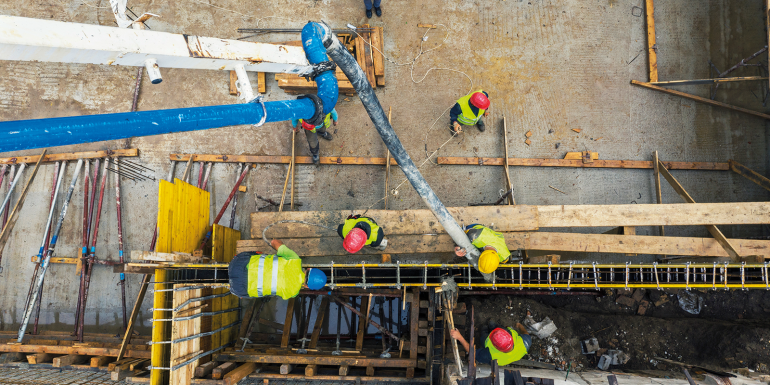All in the mix

Mehrdad Ameri Vamkani, a PhD student at the School of Civil Engineering and Built Environment at Liverpool John Moores University, has researched reducing and replacing the amount of cement used in low-strength concrete.
Low-strength concrete (LSC), which is the majority of everyday concrete used, is relatively inefficient in terms of carbon emissions. The research delves into the environmental inefficiencies linked to LSC and examines methods to decrease its embodied carbon (eCO2) through optimised mix designs.
With the construction industry responsible for 39% of energy-related global emissions, this study seeks to tackle a significant contributor: the carbon footprint of concrete, particularly in its low-strength form.
Despite its extensive use in construction, traditional LSC continues to be highly inefficient in terms of CO2 emissions due to its heavy reliance on high cement content.
This piece focuses on assessing the potential for reducing carbon emissions by integrating supplementary cementitious materials (SCMs) into concrete mixes and evaluating their effectiveness across different strength classes.
The main goal of the research is to assess real-world concrete mix designs in order to find ways to enhance the environmental efficiency of LSC. Specifically, the study aims to reduce the use of ordinary Portland cement (OPC) in concrete production by incorporating SCMs such as fly ash (FA), ground granulated blast-furnace slag and silica fume (SF).
The research involves a comprehensive analysis of 113 concrete mix designs obtained from industry data to evaluate their performance in terms of both compressive strength and eCO2 emissions.
To achieve this, an extensive review of existing literature on low-carbon concrete and its mix designs was carried out. The study utilised various data analysis techniques to assess the performance of the 113 mix designs across different strength categories. This allowed for a detailed comparison of the eCO2 emissions of different mixes, considering the type and quantity of SCMs used.
The study focused on both binary (two-component) and ternary (three-component) combinations of cementitious materials to understand the relative advantages of these approaches.
Key findings
1 Inefficiency of LSC
The study emphasises that traditional LSC is not efficient in terms of embodied carbon. Using high amounts of OPC to attain the necessary strength in LSC leads to higher eCO2 values compared to high-strength concrete (HSC).
Nonetheless, by decreasing the cement content and integrating SCMs, it is feasible to uphold the desired compressive strength while substantially reducing carbon emissions.
2 Impact of SCMs
The incorporation of SCMs has been found to play a crucial role in diminishing the environmental impact of concrete. The utilisation of binary and ternary combinations of SCMs, especially FA and SF, led to reduced eCO2 values overall. For LSC, the most effective approach was determined to be ternary mixes that combined OPC with both FA and SF.
These combinations not only decrease the cement content but also improve the strength and durability of the concrete, effectively addressing both environmental and performance considerations.
3 Binary vs ternary mixes
The research revealed that binary combinations of OPC and a single SCM were not as effective in reducing carbon emissions as ternary combinations, which involve two SCMs along with OPC. Ternary mixes, especially those incorporating both FA and SF, showed a significant reduction in eCO2 and proved to be particularly effective in low-strength applications.
These findings emphasise the importance of prioritising ternary mixes for LSC to achieve the optimal balance between performance and sustainability.
On the other hand, for HSC, binary mixes – specifically those using OPC and SF – were found to be more efficient.
The study highlighted that high-strength applications require a different composition, and binary mixes containing OPC and SF demonstrated superior carbon efficiency at higher strength levels compared to ternary mixes.
4 Role of superplasticisers
The research also investigated the impact of ‘superplasticisers’ – chemical additives that enhance the workability of concrete and decrease the water-to-cement ratio.
The study revealed that superplasticisers play a significant role in boosting the compressive strength of concrete without causing a corresponding increase in eCO2. This is particularly crucial for SCM-based mixes, as superplasticisers can counteract some of the strength reductions typically associated with FA and other SCMs during the initial curing stages.
5 Optimal concrete strength for low eCO2
One of the key findings of the study is that the optimal concrete strength for minimising eCO2 is higher than previously assumed. While theoretical research has suggested that an optimal strength of around 60MPa (megapascal) balances strength and eCO2, the data from this study indicates that higher-strength concretes (80-120MPa) are more efficient in terms of carbon emissions.
In practice, higher-strength concrete requires less material for structural applications, leading to a reduction in overall carbon emissions despite the higher cement content required to achieve these strengths.
6 Efficiency of HSC
The research confirms that HSC is generally more environmentally efficient in terms of eCO2 compared to LSC. Mixes designed for higher strength tend to have lower embodied carbon per unit of strength, especially when SF is used as a SCM. In these instances, the reduced material requirements for high-strength applications offset the higher cement content needed to achieve the strength.
Furthermore, the study found that FA is less suitable for high-strength applications, while SF plays a more significant role.
Implications for the construction industry
The findings of this study have significant implications for the construction industry’s efforts to reduce its carbon footprint. By adopting ternary mix designs for low-strength applications and binary mixes for high-strength applications, the industry can substantially reduce carbon emissions without compromising performance.
The use of SCMs, particularly in combination with superplasticisers, offers a practical and effective pathway towards more sustainable concrete production.
The study’s findings suggest that the construction industry should prioritise the use of ternary mixes for low-strength applications, where they are most effective at reducing eCO2. For high-strength applications, binary mixes that focus on OPC and SF are more efficient. In both cases, the inclusion of superplasticisers can help to optimise the strength-to-carbon ratio.
The research demonstrates that LSC, in its traditional form, is less efficient in terms of embodied carbon than HSC. However, the use of SCMs, particularly in ternary combinations, can significantly reduce the carbon footprint of LSC while maintaining the required performance characteristics. For HSC, binary mixes with SF are the most efficient.
The findings support the idea that optimising concrete mix designs through the use of SCMs and superplasticisers can lead to more sustainable construction practices.
Future research should focus on further refining these mix designs, particularly under different environmental conditions, to ensure that the industry continues to move toward net-zero carbon emissions.
This study provides a critical foundation for developing concrete mixes that are both environmentally friendly and structurally sound, offering a roadmap for reducing the carbon impact of concrete in the construction industry.
To read the full research, contact Mehrdad Ameri Vamkani on LinkedIn at b.link/LI_Vamkani
Image credit | iStock








